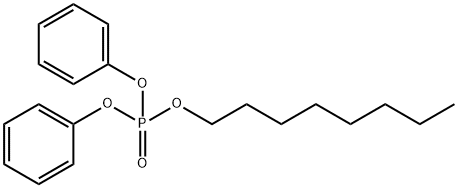| Company Name: |
Syntechem Co.,Ltd
|
| Tel: |
|
| Email: |
info@syntechem.com |
| Products Intro: |
Product Name:octyl diphenyl phosphate
CAS:115-88-8
Purity:97% Package:1g;5g;25g;100g;250g;1kg;5kg;10kg;25kg Remarks:we offer low price custom synthesis and contract manufacturing
|
|
| | diphenyl octyl phosphate Basic information |
| Product Name: | diphenyl octyl phosphate | | Synonyms: | Octyl phenyl phosphate;Phosphoric acid, octyl diphenyl;Phosphoric acid diphenyl=octyl ester;Phosphoric acid diphenyloctyl ester | | CAS: | 115-88-8 | | MF: | C20H27O4P | | MW: | 362.4 | | EINECS: | 204-113-8 | | Product Categories: | | | Mol File: | 115-88-8.mol |  |
| | diphenyl octyl phosphate Chemical Properties |
| Boiling point | 425.5±18.0 °C(Predicted) | | density | 1.1050 (rough estimate) | | refractive index | 1.5230 (estimate) | | Water Solubility | 0.14mg/L(24 ºC) | | EPA Substance Registry System | Octyl diphenyl phosphate (115-88-8) |
| | diphenyl octyl phosphate Usage And Synthesis |
| Uses | Octyl phenyl phosphate is a phosphorus flame retardant additive. | | General Description | Octyl phenyl acid phosphate is a colorless liquid. diphenyl octyl phosphate is corrosive to the skin, eyes, and mucous membranes. | | Reactivity Profile | Organophosphates, such as OCTYL PHENYL ACID PHOSPHATE, are susceptible to formation of highly toxic and flammable phosphine gas in the presence of strong reducing agents such as hydrides. Partial oxidation by oxidizing agents may result in the release of toxic phosphorus oxides. | | Health Hazard | TOXIC; inhalation, ingestion or skin contact with material may cause severe injury or death. Contact with molten substance may cause severe burns to skin and eyes. Avoid any skin contact. Effects of contact or inhalation may be delayed. Fire may produce irritating, corrosive and/or toxic gases. Runoff from fire control or dilution water may be corrosive and/or toxic and cause pollution. | | Fire Hazard | Non-combustible, substance itself does not burn but may decompose upon heating to produce corrosive and/or toxic fumes. Some are oxidizers and may ignite combustibles (wood, paper, oil, clothing, etc.). Contact with metals may evolve flammable hydrogen gas. Containers may explode when heated. |
| | diphenyl octyl phosphate Preparation Products And Raw materials |
|